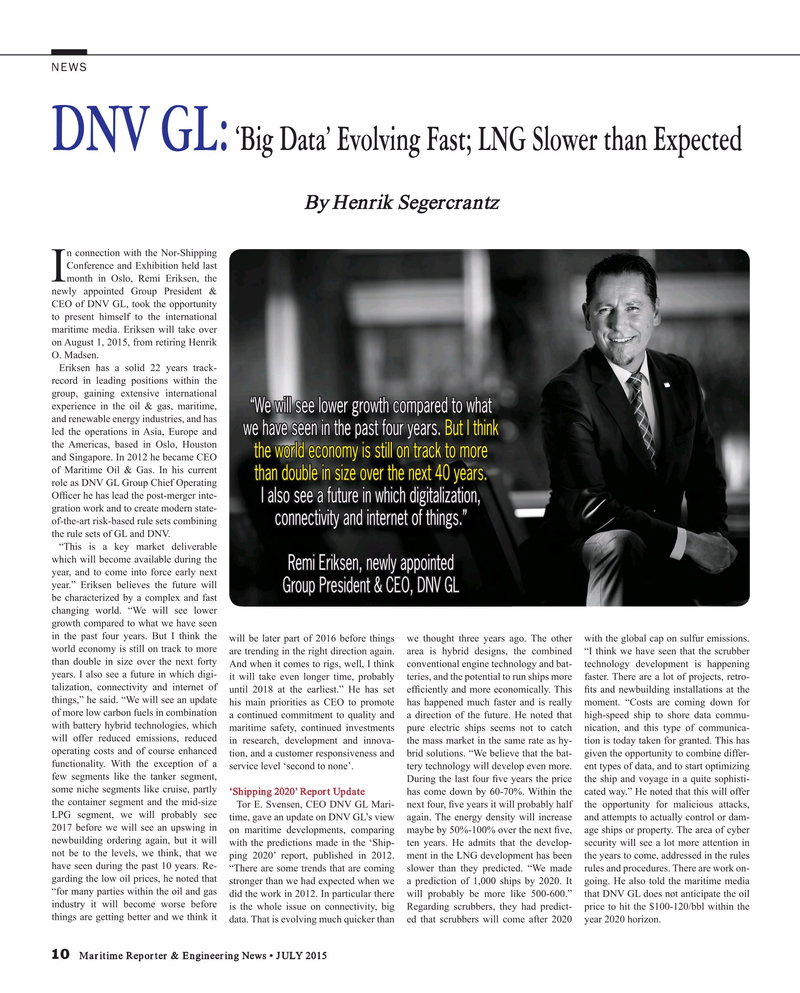
Page 10: of Maritime Reporter Magazine (July 2015)
Marine Communications Edition
Read this page in Pdf, Flash or Html5 edition of July 2015 Maritime Reporter Magazine
NEWS
DNV GL: ‘Big Data’ Evolving Fast; LNG Slower than Expected
By Henrik Segercrantz n connection with the Nor-Shipping
Conference and Exhibition held last
Imonth in Oslo, Remi Eriksen, the newly appointed Group President &
CEO of DNV GL, took the opportunity to present himself to the international maritime media. Eriksen will take over on August 1, 2015, from retiring Henrik
O. Madsen.
Eriksen has a solid 22 years track- record in leading positions within the group, gaining extensive international experience in the oil & gas, maritime, “We will see lower growth compared to what “We will see lower growth compared to what and renewable energy industries, and has led the operations in Asia, Europe and we have seen in the past four years. But I think we have seen in the past four years. But I think the Americas, based in Oslo, Houston the world economy is still on track to more the world economy is still on track to more and Singapore. In 2012 he became CEO of Maritime Oil & Gas. In his current than double in size over the next 40 years. than double in size over the next 40 years. role as DNV GL Group Chief Operating
Of? cer he has lead the post-merger inte-
I also see a future in which digitalization, I also see a future in which digitalization, gration work and to create modern state- of-the-art risk-based rule sets combining connectivity and internet of things.”connectivity and internet of things.” the rule sets of GL and DNV. “This is a key market deliverable which will become available during the
Remi Eriksen, newly appointed Remi Eriksen, newly appointed year, and to come into force early next year.” Eriksen believes the future will
Group President & CEO, DNV GLGroup President & CEO, DNV GL be characterized by a complex and fast changing world. “We will see lower growth compared to what we have seen in the past four years. But I think the will be later part of 2016 before things we thought three years ago. The other with the global cap on sulfur emissions. world economy is still on track to more are trending in the right direction again. area is hybrid designs, the combined “I think we have seen that the scrubber than double in size over the next forty And when it comes to rigs, well, I think conventional engine technology and bat- technology development is happening years. I also see a future in which digi- it will take even longer time, probably teries, and the potential to run ships more faster. There are a lot of projects, retro- talization, connectivity and internet of until 2018 at the earliest.” He has set ef? ciently and more economically. This ? ts and newbuilding installations at the things,” he said. “We will see an update his main priorities as CEO to promote has happened much faster and is really moment. “Costs are coming down for of more low carbon fuels in combination a continued commitment to quality and a direction of the future. He noted that high-speed ship to shore data commu- with battery hybrid technologies, which maritime safety, continued investments pure electric ships seems not to catch nication, and this type of communica- will offer reduced emissions, reduced in research, development and innova- the mass market in the same rate as hy- tion is today taken for granted. This has operating costs and of course enhanced tion, and a customer responsiveness and brid solutions. “We believe that the bat- given the opportunity to combine differ- functionality. With the exception of a service level ‘second to none’. tery technology will develop even more. ent types of data, and to start optimizing few segments like the tanker segment,
During the last four ? ve years the price the ship and voyage in a quite sophisti- some niche segments like cruise, partly ‘Shipping 2020’ Report Update has come down by 60-70%. Within the cated way.” He noted that this will offer the container segment and the mid-size
Tor E. Svensen, CEO DNV GL Mari- next four, ? ve years it will probably half the opportunity for malicious attacks,
LPG segment, we will probably see time, gave an update on DNV GL’s view again. The energy density will increase and attempts to actually control or dam- 2017 before we will see an upswing in on maritime developments, comparing maybe by 50%-100% over the next ? ve, age ships or property. The area of cyber newbuilding ordering again, but it will with the predictions made in the ‘Ship- ten years. He admits that the develop- security will see a lot more attention in not be to the levels, we think, that we ping 2020’ report, published in 2012. ment in the LNG development has been the years to come, addressed in the rules have seen during the past 10 years. Re- “There are some trends that are coming slower than they predicted. “We made rules and procedures. There are work on- garding the low oil prices, he noted that stronger than we had expected when we a prediction of 1,000 ships by 2020. It going. He also told the maritime media “for many parties within the oil and gas did the work in 2012. In particular there will probably be more like 500-600.” that DNV GL does not anticipate the oil industry it will become worse before is the whole issue on connectivity, big Regarding scrubbers, they had predict- price to hit the $100-120/bbl within the things are getting better and we think it data. That is evolving much quicker than ed that scrubbers will come after 2020 year 2020 horizon.
10 Maritime Reporter & Engineering News • JULY 2015
MR #7 (10-17).indd 10 MR #7 (10-17).indd 10 7/6/2015 9:25:41 AM7/6/2015 9:25:41 AM

 9
9

 11
11
